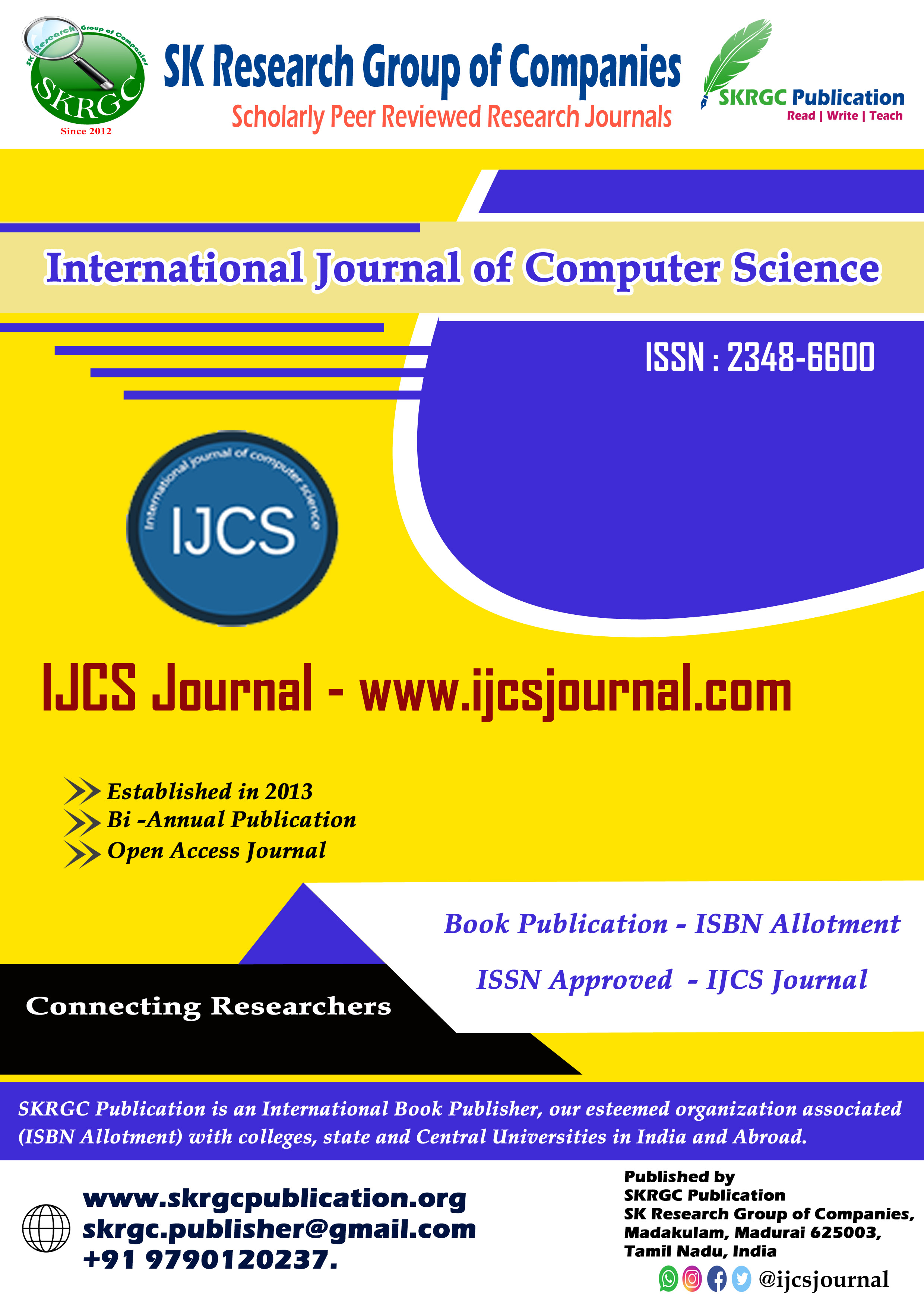EXAMINE THE CONVERGENCE OF SOFTWARE ENGINEERING'S MULTI-DOMAIN RESEARCH OPPORTUNITIES
International Journal of Computer Science (IJCS) Published by SK Research Group of Companies (SKRGC)
Download this PDF format
Abstract
A significant part of the software industry is played by Software Engineering (SE), since almost every industry, business, and operation requires a specific type of software. Throughout the course of an application's lifecycle, software engineering offers a variety of levels that fulfill various purposes. The sector first created applications mostly for home usage and small businesses. At that point, the accounting data is also monitored, and the SDLC processes are highly minimal and controlled. The quantity of complex applications required by the software industry revolution clearly results in high-quality SDLC.
References
[1] Xu, Haiping, Future Research Directions of Software Engineering and Knowledge Engineering. International Journal of Software Engineering and Knowledge Engineering. 415-421, 2015.
[2] Abran, A., Moore, J.W., Bourque, P., Dupuis, R., Tripp, L.L.: Guide to the Software Engineering Body of Knowledge, IEEE, 2004
[3] Bhalerao, Shilpa & Puntambekar, Devendra & Ingle, Maya, Generalizing Agile Software Development Life Cycle. International Journal on Computer Science and Engineering. 1, . 2009.
[4] Agile Manifesto, http://agilemanifesto.org [5] Taylor, Q.and Giraud-Carrier, C. “Applications of data mining in software engineering”, International Journal of Data Analysis Techniques and Strategies, Volume 02, Issue 03, Page No (243- 257), July 2010.
[6] M. Halkidia, D. Spinellisb, G. Tsatsaronisc and M.Vazirgiannis, “Data mining in software engineering”, Intelligent Data Analysis 15, Page No (413–441), 2011.
[7] M. Aouf, L. Lyanage, and S. Hansen, “Critical review of data mining techniques for gene expression analysis,” International Conference on Information and Automation for Sustainability (ICIAFS) 2008, Page No (367-371), 2008.
[8] C. CHANG and C. CHU, “Software Defect Prediction Using Inter transaction Association Rule Mining”, International Journal of Software Engineering and Knowledge Engineering, Volume 19, Issue 06, Page No (747-764), September 2009.
[9] M. Gegick, P. Rotella and T. Xie, “Identifying security bug reports via text mining: an industrial case study”, Mining Software Repositories (MSR), 7th IEEE Working Conference, Page No (11– 20), 2010.
[10] P. Runeson, and O. Nyholm, “Detection of duplicate defect reports using natural language processing”, Software Engineering, 2007. ICSE 2007. 29th International Conference, Page No (499 – 510), 2007.
[11] M. Z. Islam and L. Brankovic, “Detective: a decision tree based categorical value clustering and perturbation technique for preserving privacy in data mining,” Third IEEE Conference on Industrial Informatics (INDIN), Page No (701-708), 2005.
[12] P. C. H. Ma and K. C. C. Chan, “An iterative data mining approach for mining overlapping coexpression patterns in noisy gene expression data,” IEEE Trans. NanoBioscience, Volume 08, Issue 03, Page No (252-258), September 2009.
[13] V. Simko, P. Kroha and P. Hnetynka, “Implemented domain model generation”, Technical Report, Department of Distributed and Dependable Systems, Report No. D3S-TR-2013-03, 2012.
[14] F. Meziane, N. Athanasakis and S. Ananiadou, “Generating Natural Language Specifications from UML Class diagrams”, Requirement Engineering Journal, Springer-Verlag, London, vol. 13, no. 1, pp. 1-18, 2013.
[15] R. Giganto, “Generating Class Models through Controlled Requirements”, New Zealand Computer Science Research Conference (NZCSRSC), Christchurch, New Zealand, 2008.
[16] G. Lu, P. Huang, L. He, C. Cu and X. Li, “A New Semantic Similarity Measuring Method Based on Web Search Engines”, WSEAS Transaction on Computer, ISSN: 1109-2750, vol. 9, Issue 1, 2010.
[17] S. Konrad and B. H. C. Cheng, “Automated Analysis of Natural Language Properties for UML Models”, [Online available], 2010.
[18] T. Xie, S. Thummalapenta, D. Lo and C. Liu, Data mining for software engineering, Computer 42, 55–62, 2009.
[19] Marcel Bruch, Martin Monperrus, Mira Mezini. Learning from Examples to Improve Code Completion Systems. In Proceedings of the 7th joint meeting of the European Software Engineering Conference and the ACM Symposium on the Foundations of Software Engineering, ACM, 2009.
[20] https://reprints.forrester.com/#/assets/2/108/'RES121339'/reports
[21] M Saeki, H Horai, H Enomoto, "Sofitware Development Process from Natural Language Specification", 1lth International Conference on Software Engineering, 1989.
[22] P Loucopoulos P & R E M Champion, "Concept Acquiisition and Analysis for Requirements Acquisition", IEE Software Engineering Journal, (2) 1990.
[23] Kalbandi, Ishwarappa & Anuradha, J, A Brief Introduction on Big Data 5Vs Characteristics and Hadoop Technology. Procedia Computer Science, 2015.
[24] Seok Won Lee and Robin A. Gandhi. Ontology-based Active Requirements Engineering Framework. In Proc. of the 12th Asia- Pacific Software Eng. Conf. 481–490, 2005.
[25] Holger Knublauch. Ontology-Driven Software Development in the Context of the Semantic Web: An Example Scenario with Protege/OWL. In Proc. of 1st Int’l WSh on the Model-Driven Semantic Web, 2004.
[26] Gerti Kappel, Elisabeth Kapsammer, Horst Kargl, Gerhard Kramler, Thomas Reiter, Werner Retschitzegger, Wieland Schwinger, and Manuel Wimmer. Lifting Metamodels to Ontologies: A Step to the Semantic Integration of Modeling Languages. In Proc. of the ACM/IEEE 9th Int’l Conf. on Model Driven Eng. Languages and Sys., pages 528–542, 2006.
[27] Christoph Kiefer, Abraham Bernstein, and Jonas Tappolet. Analyzing Software with iSPARQL. In Proc. the 3rd ESWC Int’l WSh. on Semantic Web Enabled Software Eng., 2007.
[28] Ren´e Witte, Yonggang Zhang, and Juergen Rilling. Empowering Software Maintainers with Semantic Web Technologies. In Proc. of the 4th European Semantic Web Conference, pages 37–52. Springer, 2007.
[29] C´esar Gonz`alez-P`erez and Brian Henderson-Sellers. An Ontology for Software Development Methodologies and Endeavours, volume Ontologies for Software Engineering and Software Technology, pages 123–151. Springer, 2006.
[30] Anupriya Ankolekar, Katia Sycara, James Herbsleb, Robert Kraut, and Chris Welty. Supporting Online Problem-solving Communities with the Semantic Web. In Proc. of the 15th Int’l conf. on WWW, pages 575–584, 2006.
[31] P. Tetlow, J. Z. Pan, D. Oberle, E. Wallace, M. Uschold, and E. Kendall. Ontology Driven Architectures and Potential Uses of the Semantic Web in Systems and Software Engineering. W3C Working Draft, 2006.
[32] OMG ODM. Ontology Definition Metamodel, 2006. http://www.omg.org/cgibin/doc?ad/06-05-01.pdf.
[33] Hans-J¨org Happel and Stefan Seedorf. Applications of Ontologies in Software Engineering. In Proc. of the Int’l WSh. on Semantic Web Enabled Software Engineering, 2006.
Keywords
Software Engineering, AI, Natural Language Processing, Data Mining, Big Data

